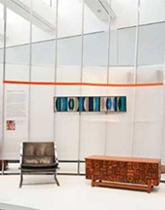For 50 years, Los Angeles-based artist/designers Evelyn and Jerome Ackerman played a central role in the distinctive aesthetic of California mid-century modernism. Employing their deep knowledge of fine art, traditional craft, and design, the couple created a body of work remarkable for its diversity of styles, techniques, and materials.
Jerome (“Jerry”) and Evelyn Ackerman brought their creativity, optimism, versatility, and hard work together in a shared life and career spanning five decades. In joining their complementary talents, Jerome and Evelyn strove to make beautiful yet affordable and accessible designs for homes and offices. Their life represents a true marriage of art and design that resulted in a prolific output of ceramics, mosaics, textiles, woodcarvings, hardware, and metal that embodied a modernist sensibility. The Ackermans shared a belief in and a passion for the transformative power of modern design with other celebrated post-war design couples Charles and Ray Eames, Robin and Lucienne Day, Josef and Anni Albers, and Massimo and Lella Vignelli.
The creative direction of their work grew out of the principles of the Bauhaus, a design movement based on an influential German art and design school that flourished from 1919 to 1933. Building on the Bauhaus belief that fine and applied arts are equally important, the Ackermans integrated their training in fine art and craftsmanship over the course of their long and prolific professional career, exploring materials and techniques to create original and iconic pieces. Their signature design style moved from abstract modernism to figurative stylization, highlighting Evelyn’s intuitive use of pattern, color, line, and proportion. Playing a central role as designer-craftsmen, Jerome and Evelyn Ackerman helped to shape what is now known as California mid-century modern style.
The Ackermans hold the rare distinction of being included in every exhibition (1954 to 1976) of the prestigious “California Design” series, held primarily at the former Pasadena Art Museum. The couple has been the subject of numerous articles in the local and national press and their pieces are in many public and private collections. The first major retrospective of their work, “Masters of Mid-Century California Modernism: Evelyn and Jerome Ackerman,” was held at the Mingei International Museum in San Diego (2009–2010). Their work has continued to appear regularly in museum exhibitions.
Hand-in-Hand: Ceramics, Mosaics, Tapestries, and Woodcarvings by the California Mid-Century Designers Evelyn and Jerome Ackerman by Dan Chavkin and Lisa Thackaberry was published in the Fall of 2014 by Pointed Leaf Press. The book about the Ackermans’ life and work—called a “gorgeous homage” by Los Angeles Magazine—received excellent reviews in the Los Angeles Times, The New York Times, Architectural Digest, and Uppercase among others. With a foreword by Jonathan Adler and chapter contributions by David Keeps, Dale Carolyn Gluckman, Jo Lauria, and Jeffrey Head, the book features original drawings, vintage installations, and personal and product photographs.

Evelyn & Jerome
1949
The Early Years: Detroit to Los Angeles
Growing up just blocks apart in Depression-era Detroit, Evelyn and Jerry didn’t meet until they were in college, despite having attended the same elementary, middle, and high schools.
Jerry graduated from Detroit’s Central High School in 1939 and enrolled at Wayne University (now Wayne State University) as an art major. In 1941, when the United States entered World War II, he left school to work in a naval ordnance plant and then joined the Air Force, serving as a control tower operator in Germany.
In 1941 Evelyn graduated from Central High and began at the University of Michigan as an art major. Then, in 1942, her father died and her three brothers entered the military. With her mother in need of help, she transferred to Wayne University as a fine arts and art history major. There she was introduced to the German Expressionists, Rembrandt, Cézanne, Klee, and Matisse by her art history professor, Dr. Ernst Scheyer. After completing her BFA degree with distinction in 1945, Evelyn was offered a scholarship at Wayne to complete her MFA degree in fine arts.
Jerry was discharged from the Air Force in 1946 in California. His brother and aunt were in Los Angeles and he lived with them for six months, enjoying the laid-back culture and sunny beaches. Then he decided to return to Detroit where he had more friends and family.
In 1948 a friend told Jerry that he had recently attended the opening of Lucé Lipton Interior Designs where he had been introduced to Evelyn Lipton. He felt that Jerry should make it a point to meet her. Later that year Jerry found himself in the neighborhood and stopped in at the studio where he spotted a beautiful young woman sorting fabrics. She looked familiar, and it turned out that they had met some years earlier at the Wayne art department. They began dating, fell in love, and were married on September 12, 1948.
In 1949, Jerry decided to complete his college education and returned to Wayne University. Under the GI bill, he received $130 a month for tuition, supplies, and living expenses.
Among the many art classes he took at Wayne was ceramics taught by John Foster, who emphasized Chinese pottery and the work of Hamada and Bernard Leach. During Jerry’s senior year, Charles Harder, chairman of the New York State College of Ceramics at Alfred University, was the invited guest juror of the senior art exhibition at Wayne. Impressed by Jerry’s work, he offered him a place in the prestigious Alfred graduate program. Jerry received his MFA degree in ceramics in June 1952.
Shortly after marrying, Jerry and Evelyn visited his parents, who had moved to Los Angeles. While there, they met Beatrice Wood and Gertrud and Otto Natzler. They also met John Follis, who, with Rex Goode, designed a series of large-scale ceramic planters they subsequently sold to Max and Rita Lawrence, who formed Architectural Pottery. All became lifelong friends.
As art students in 1949, Evelyn and Jerry found inspiration for a creative vision that changed their life and career. “For Modern Living,” an exhibition organized by Alexander Girard at the Detroit Institute of Arts, showcased the work of several innovative contemporary designers, including Ray and Charles Eames and George Nelson furniture, Kurt Versen lighting, and V’Soske carpets. “It opened our eyes to an exciting new way of thinking and design expression. We thought, if the Eames can do it, why can’t we?” remembers Jerry.
Drawn by the temperate climate and the lively postwar artistic community, the couple moved to California in 1952 to establish themselves as designer-craftsmen. In their search for a place to live and set up their studio, they visited northern California where they met Joe Eichler, who was building architect-designed homes in the Bay Area. When the Ackermans worried aloud that they wouldn’t be able to make a living, Eichler assured them, “I plan to build hundreds of homes here and you can sell a pot to each person who owns one!” Ultimately, they moved to Los Angeles where each had a brother and where they felt there was a more established artistic community.
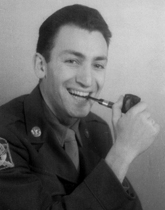
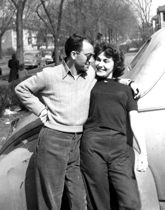
Air Force
1941
Jerry & Evelyn, Detroit
1948
The Marriage of Art and Life: Jenev Design Studio
Renting a small space at 2207 Federal Avenue in West Los Angeles, the Ackermans opened Jenev Design Studio, a combination of their first names. With very little money, they set about building a successful career based on ingenuity, talent, and hard work. Jerry began creating his first group of slip cast pottery, using the skills he had honed at Alfred. Designing shapes, making molds, and developing glazes consumed nearly a year. Jenev’s first client was Carroll Sager Associates and Jules Seltzer, a prominent Los Angeles showroom for modernist furniture. During this same period, they also designed a number of products for Cal Pacific Imports. Evelyn supplemented their income by working as a secretary, answering fan mail for comedian Red Skelton.
As sales increased, the Jenev ceramics line was marketed nationally by independent sales representatives. It was also personally selected by Paul McCobb for sale in his Directional Showroom. Jerry and Evelyn’s work began to appear in the Los Angeles Times Home magazine and House and Garden as well as other newspapers, home furnishing and interior design magazines, and trade journals. The Ackermans met and became friends with fellow members of the American Ceramic Society, including Peter Voulkos, Otto and Vivika Heino, Malcolm Leland, and Laura Andreson.
In 1955, intrigued by a mosaic in a San Francisco exhibition, Evelyn began designing mosaics for tables and wall panels. Many of the designs were featured in home and interior magazines, as well as in the “California Design” exhibitions. While Evelyn initially made all the prototypes, she and Jerry soon realized that she would not be able to keep up with demand. They established a mosaic workshop in Mexico so that Evelyn could focus solely on creating new designs and they could be assured of a steady supply of products.
On November 1, 2017, Design Within Reach launched a collection of six of the original Jenev ceramic designs. The molds for the collection were made from Jerry’s 1953 originals.
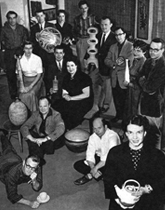
American Ceramic Society
1956
A Shared Vision: ERA Industries
Jerry reconnected with a high school classmate, Sherrill Broudy, in 1956. Sharing a love of architecture and design, they decided to become business partners. Jenev became ERA Industries, the name the business retains to this day. After several years, the Ackermans bought Broudy out. With this transition, the couple began to apply their talents to a wider variety of media, designing home accessories and architectural elements in the form of textiles, wood, metal, and mosaic. They employed an innovative combination of traditional techniques and modern production approaches.
Later that year the Ackermans bought a small tract house in Culver City from Evelyn’s brother Milton, who had graduated from Art Center School as a photographer. Milton had begun work on a studio addition and Evelyn and Jerry completed it several years later. It eventually became their design studio.
Harold Grieve, a well-known interior designer, held an exhibition of Jerry and Evelyn’s work, which included a mosaic table, a wall mosaic, and Jerry’s hand-thrown stoneware pottery. The show was in the first home of the Los Angeles County Museum of Art in Exposition Park. Evelyn completed designs for two exterior architectural mosaic murals commissioned for buildings in West Los Angeles and Santa Barbara. Fantasy Landscape, developed for an apartment building, was featured in an article in the Los Angeles Times Home magazine and is registered with the Los Angeles Mural Conservancy. In Santa Barbara, Sea, Land, and Sky still graces the front of a law building.
Always exploring new materials, Jerry and Evelyn became interested in several processes involving aluminum and created a number of special commissions. Warrior King was selected for the second “California Design” exhibition at the Pasadena Art Museum.
Evelyn had taken weaving in college and they decided to add woven tapestries to their product line. It soon became apparent that Evelyn alone could not meet the demand. They found a family of skilled weavers outside of Mexico City to execute the designs. Their relationship lasted for many years. Evelyn’s first design, Hot Bird, featured on the cover of the Los Angeles Times Home magazine, was followed by a steady stream of new tapestries. Evelyn also designed a number of wall hangings that were silk-screened onto fabric.
The Ackermans decided it was time to have their own showroom for the architecture and design trade featuring their unique designs. They opened their first showroom in 1959 on Melrose Avenue and San Vicente Boulevard, across from where the Pacific Design Center is now located. The next year, their daughter, Laura, was born.
In 1964, when they outgrew their showroom on Melrose, they moved to larger quarters on Beverly Boulevard, across from the Herman Miller showroom. This location, in the heart of the design trade, offered premier exposure and better opportunities for interactions with architects and interior designers. In the following years, Jerry and Evelyn created designs individually and as a team as the business grew. Eventually, Jerry decided to concentrate on product design and development and marketing.
Contract furnishings and interior design represented a large market. Ackerman designs were featured at major department stores such as Bloomingdale’s, Macy’s, and Bullock’s, as well as at established contemporary design stores across the country. To better serve these clients, the Ackermans decided to showcase the work of other artists and craftsmen and pursue more custom projects. At the same time, they realized the need to continually add new designs to each of their lines. One of the most popular lines was a group of hand-hooked wall hangings Evelyn designed that were produced in Japan.
The Ackermans’ knowledge of traditional craft techniques led them to utilize the handwork skills of craftsmen in Greece, Kashmir, Italy, Japan, and Mexico. By pursuing limited production runs, they were able to maintain high quality while keeping their products affordable. Detailed instructions, with full-size drawings and color keys, were sent for each new design. By adding new designs on a regular basis, they were able to maintain a fresh look in their lines.
While many of their artist-craftsmen peers became known for working in one medium and style, the Ackermans’ creative expression was multifaceted, broad, and diverse. Evelyn’s versatile design styles ranged from geometric minimalism to biomorphic abstraction to whimsical stylization. She and Jerry were able to translate imagery from one medium to another. The same design could be made as a woven tapestry as well as reproduced in metal, mosaic, or wood to maximize both the development investment and the design’s appeal. In order to accommodate homeowners’ differing tastes, Evelyn developed palettes for textiles and mosaics in both cool and warm color schemes.
Jerry adapted production techniques to create products that maintained a handcrafted look. Woodcarvings, for example, were first roughed out using the furniture manufacturing technique of multiple spindle carving, then each piece was hand finished by a carver. Evelyn designed a series of modular carved wood panels with tongue-and-groove details for their former business partner, Sherrill Broudy, to be used in architectural applications. These panels formed the nucleus for Broudy’s company Panelcarve (later Forms+Surfaces). One of Evelyn’s most popular carved wood designs was the Ucello series.
Responding to a need for more well-designed, contemporary cabinet hardware, Jerry designed a new series. His hand-cast solid brass pulls and knobs were produced in Italy with a variety of inlays and finishes. They supplemented ERA’s line of recessed plastic pulls designed by Count Sigvard Bernadotte and produced in Denmark that were favored by architects.
From the beginning, much of the Ackermans’ work was special commissions. In 1968 Evelyn began the execution of 12 custom 6’ x 8’ needlepoint tapestries for the new Litton Industries corporate office in Beverly Hills. The tapestries were made in Greece using Evelyn’s full-size drawings and specifications. The project took a year and a half to complete.

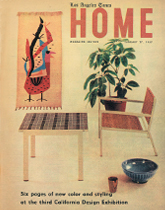
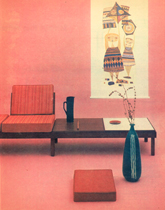

(From top)
Fantasy Landscape Installation
1956
Los Angeles Times Home
1957
Los Angeles Times Home
1958
Los Angeles Times Home
1959
Return to the Studio: Later Works
By the late 1980s, the couple decided to cut back on designing and manufacturing new products for ERA. Jerry represented several other lines of fine interior and architectural products and continued to work with the architects and interior designers with whom he had long-standing relationships. The Ackermans refocused their creative energies on individual projects, returning to their home studio.
As he reduced his time with ERA Industries, Jerry resumed his ceramic pursuits. While still a traditional potter, he introduced more whimsical, decorative elements into his hand-thrown pots. His new work, comprising both functional pieces and sculptural forms, has appeared in several gallery and museum exhibitions in the past decade.
Evelyn spent a year and a half creating a 40-piece series of cloisonné enamels, Stories from the Bible which is now in the permanent collection of the Renwick Gallery, Smithsonian American Art Museum, Washington, D.C. Over the years, Evelyn collected antique toys and dolls and became a respected expert. She authored hundreds of articles and published five books on antique dolls and toys. Her successful pattern books for dressing antique dolls, the first that were based on research and were authentic expressions of the dress of the period, were reissued. In the 1980s, she volunteered at the Los Angeles County Museum of Art Costume and Textile department and wrote a monograph on nineteenth-century dress and an extensive glossary for a catalogue of eighteenth-century costumes and textiles.
In September 2008 the Museum of California Design (MOCAD) honored Jerry and Evelyn for their exceptional contributions to American design. Aptly hosted at a mid-century modern home designed in 1954 for Gary Cooper by celebrated Los Angeles architect A. Quincy Jones, the event reflected on their extraordinary partnership and creative energy. Jerry and Evelyn received the 2010 Wayne State University Distinguished Alumni Award in recognition of their outstanding accomplishments, contributions, and service. They were honored at an awards gala and commencement where President Jay Noren said, “We are so proud of your accomplishments.” Jerry was honored with the 2010 Alfred University Alumni Award for Distinguished Achievement at the 124th Annual Alumni Association Awards Picnic. The award recognizes alumni whose achievements in their profession, career, or avocational pursuits bring honor and distinction to the University. In 2013, the Los Angeles Conservancy Modern Committee presented them with its Modern Masters Award, recognizing a lifetime of achievement in the fields of modern architecture and design.
Today, the Ackermans’ work, highly acclaimed over the course of their 50-year collaborative partnership, is being rediscovered by both design historians and a new generation of mid-century design collectors. Hand-in-Hand: Ceramics, Mosaics, Tapestries, and Woodcarvings by the California Mid-Century Designers Evelyn and Jerome Ackerman was published following the successful retrospectives “Masters of Mid-Century California Modernism: Evelyn and Jerome Ackerman,” curated by Dale Carolyn Gluckman and Jo Lauria (former curators at the Los Angeles County Museum of Art), at the Mingei International Museum in San Diego, California (March 2009–January 2010) and “A Marriage of Craft and Design: The Work of Evelyn & Jerome Ackerman” at the Craft and Folk Art Museum in Los Angeles (January–May, 2011).
Multiple museum exhibitions have featured the couples’ designs. “Pacific Standard Time: Art in L.A., 1945–1980,” sponsored by the Getty Foundation, included more than 60 institutions focusing on the rise of the art scene in Los Angeles. The Ackermans’ work was featured in three exhibitions: “California Design, 1930–1965: Living in a Modern Way” at the Los Angeles County Museum of Art (October 1, 2011–March 25, 2012), “Common Ground: Ceramics in Southern California 1945-1975” at the American Museum of Ceramic Art (November 12, 201–March 31, 2012), and “The Golden State of Craft: California 1960–1985” at the Craft and Folk Art Museum (September 25, 2011–January 8, 2012). A follow up to Pacific Standard Time “Found in Translation: Design in California and Mexico, 1915–1985” at the Los Angeles County Museum of Art (September 17, 2017–April 1, 2018) highlighted pieces in the show and catalog.
A documentary film “In Tandem: The Life and Work of Jerry and Evelyn Ackerman” by Margaret Halkin and Katie Nartonis premiered at a sold-out Palm Springs Modernism Week event “Masters of California Mid-Century Design: The Story of Evelyn and Jerome Ackerman.” Sponsored by Eisenhower Health Center, the event included a panel discussion, slide show, exhibition, and. Multiple Ackerman pieces are now part of the permanent collection of the Eisenhower Health Center, complimenting the renovated 1971 Donald Wexler building on Palm Canyon Drive in Palm Springs, CA.
While Evelyn passed away on November 28, 2012, and Jerry passed away on March 30, 2019, their extraordinary personal and design legacy continues to inspire and influence.
Portions of this material adapted wih permission from Dale Carolyn Gluckman and Jo Lauria, co-curators, “Masters of Mid-Century California Modernism: Evelyn and Jerome Ackerman,” Mingei International Museum (Feb. 2009 through Jan. 2010).


